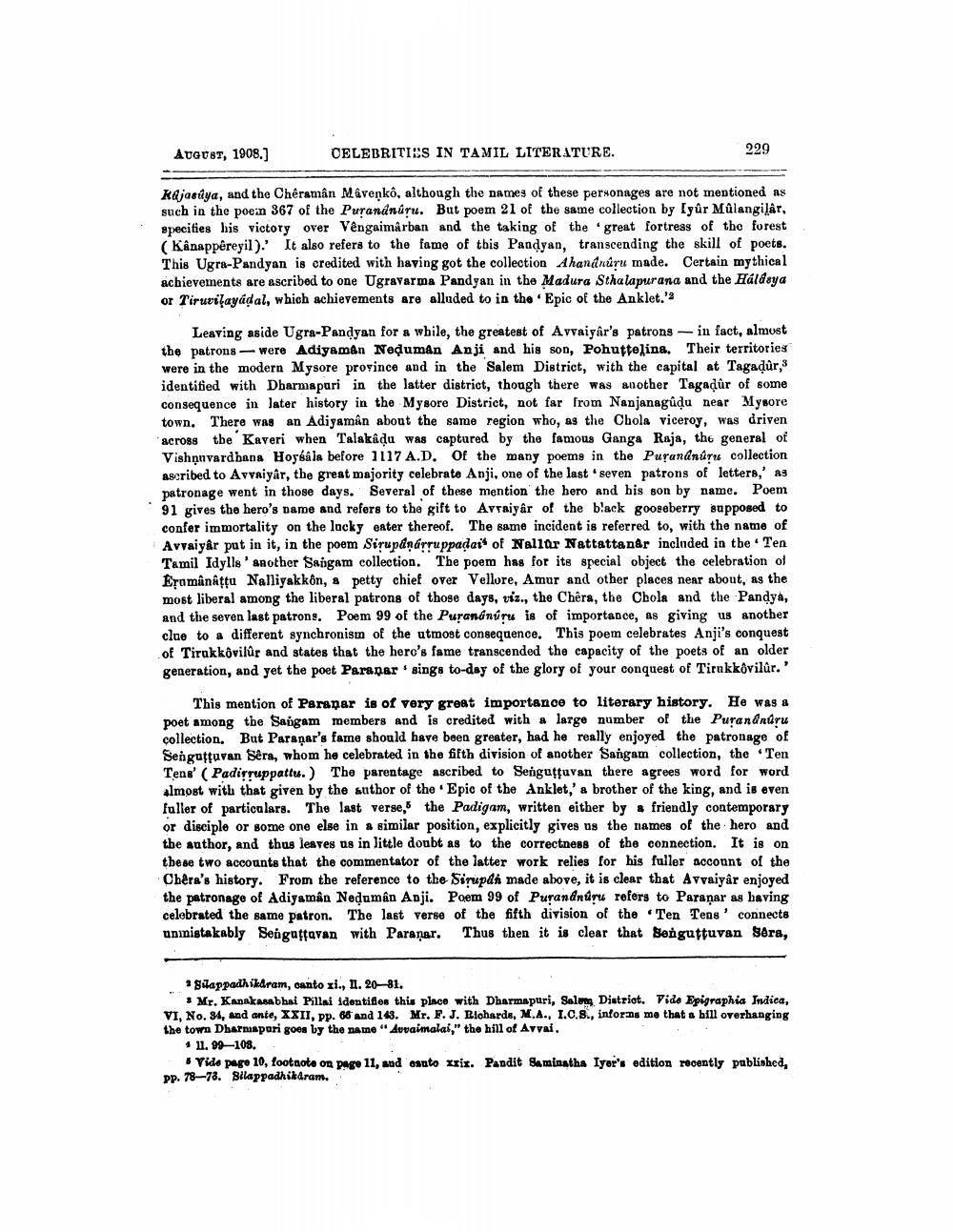________________
AUGUST, 1908.)
CELEBRITIES IN TAMIL LITERATURE.
229
Kdjasiya, and the Chéraman Maveņkô, although the names of these personages are not mentioned as such in the poein 367 of the Purandnúru. But poem 21 of the same collection by Cyûr Mûlangiler, specifies his victory over Vêngaimàrban and the taking of the great fortress of the forest (Kanappêreyil).' It also refers to the fame of this Pandyan, transcending the skill of poets. This Ugra-Pandyan is credited with having got the collection Ahandrúru made. Certain mythical achievements are ascribed to one Ugravarma Pandyan in the Madura Sthalapurana and the Háldoya or Tiruvilayadal, which achievements are alluded to in the Epic of the Anklet.'
Leaving aside Ugra-Pandyan for a while, the greatest of Avvaiyâr's patrons - in fact, almust the patrons — were Adiyaman Neduman Anji and his son, Pohuttelina. Their territories were in the modern Mysore province and in the Salem District, with the capital at Tagadûr,3 identified with Dharmapari in the latter district, though there was another Tagađùr of some consequence in later history in the Mysore District, not far from Nanjanagûdu near Mysore town. There was an Adiyamân about the same region who, as the Chola viceroy, was driven across the Kaveri when Talakadu was captured by the famous Ganga Raja, the general of Vishạnvardbana Hoyśáls before 1117 A.D. Of the many poems in the Purandnútu collection ascribed to Avvaiyar, the great majority celebrate Anji, one of the last seven patrons of letters,' as patronage went in those days. Several of these mention the hero and his son by name. Poem 91 gives the hero's name and refers to the gift to Avraiyâr of the black gooseberry supposed to confer immortality on the lucky eater thereof. The same incident is referred to, with the name of Avvaiyâr pat in it, in the poem Sirupanárruppadait of Nallar Nattattanar included in the Ten Tamil Idylls' another Sangam collection. The poem has for its special object the celebration of Eramânațţu Nalliyakkôn, & petty chief over Vellore, Amur and other places near about, as the most liberal among the liberal patrons of those days, viz., the Chêra, the Chola and the Pandya, and the seven last patrons. Poem 99 of the Purananúru is of importance, as giving us another clue to a different synchronist of the utmost consequence. This poem celebrates Anji's conquest of Tirakkóvilůr and states that the hero's fame transcended the capacity of the poets of an older generation, and yet the poet Parapar. sings to-day of the glory of your conquest of Tirukkóvilûr.'
This mention of Paranar is of very great importance to literary history. He was a poet among the Sangam members and is credited with a large number of the Purananúru collection. But Paranar's fame should have been greater, had he really enjoyed the patronage of Sengattavan Sêra, whom he celebrated in the fifth division of another Sangam collection, the Ten Tens' (Padigruppattu.) The parentage ascribed to Serguttuvan there agrees word for word almost with that given by the author of the Epic of the anklet,' a brother of the king, and is even fuller of particulars. The last verse, the Padigam, written either by a friendly contemporary or disciple or some one else in a similar position, explicitly gives us the names of the hero and the author, and thus leaves us in little doubt as to the correctness of the connection. It is on these two accounts that the commentator of the latter work relies for his fuller account of the Chera's history. From the reference to the Sirupda made above, it is clear that Avvaiyâr enjoyed the patronage of Adiyaman Neduman Anji. Poem 99 of Purandndru refers to Parañar as having celebrated the same patron. The last verse of the fifth division of the Ten Tens' connects unnistakably Sengattavan with Paranar. Thus then it is clear that Senguttuvan Sera,
Silappadhikdram, canto xi., 11. 2081.
Mr. Kanakasabhai Pillai identifies this place with Dharmapuri, Salong Distriot. Vido Epigraphia Indica, VI, No. 81, and ante, XXII, pp. 68 and 143. Mr. F. J. Richards, M.A., I.C.S., intorns me that a bill overhanging the town Dharnispari goes by the name "Avvaimalai," the hill of Avvai,
+ 11. 99-108.
5 Vide pago 10, footnote on page 11, sad osuto xxix. Pandit Saminatha Iyor's edition recently published, PP. 73-78. Bilappadhikdram.




